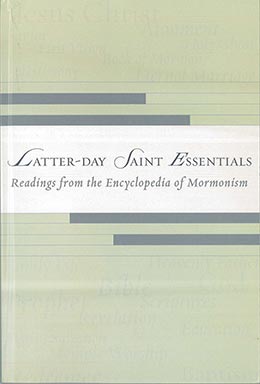First Vision
Milton V. Backman
Milton V. Backman Jr., "First Vision," in Latter-day Saint Essentials: Readings from the Encyclopedia of Mormonism, ed. John W. Welch and Devan Jensen (Provo, UT: BYU Studies and the Religious Studies Center, Brigham Young University, 2002), 19–21.
The First Vision of the Prophet Joseph Smith is the beginning point, the fountainhead, of the restoration of the gospel in this dispensation. This theophany occurred in a grove near Palmyra, New York, in the spring of 1820.
Joseph’s narratives record that when he was in his twelfth year he began to sense the need for redemption and investigated several religious groups. A short time after his family moved to Manchester, New York, he witnessed unusual religious excitement in the area, bringing divisions of allegiance in his community and family. As converts began filing off to one faith and another, he observed that their professed good feelings for each other were lost in “a strife of words and a contest about opinions” (Joseph Smith—History 1:5–8). Confused and concerned, he asked himself, “If any one of them be right which is it? And how shall I know it?” (Backman, pp. 156, 162, 168; Jessee, p. 198).
Searching the scriptures, Joseph was influenced by an admonition to prayer in the epistle of James. “If any of you lack wisdom, let him ask of God” (James 1:5). “Never,” he later recalled, “did any passage of scripture come with more power to the heart of man than this did at this time to mine” (Joseph Smith—History 1:12). He retired to a secluded grove near his father’s log-cabin farmhouse and knelt in prayer (Backman, p. 156).
A struggle with a satanic influence followed, but with divine help he survived it. As he continued to call upon God, he records, “I saw a pillar of light exactly over my head, above the brightness of the sun, which descended gradually until it fell upon me.” Immediately he was delivered from oppressive darkness (Joseph Smith—History 1:16). Within the light, he saw two personages “whose brightness and glory defy all description” and who “exactly resembled each other in features and likeness: (Joseph Smith—History 1:17; Backman, p. 169). One of them spoke his name, pointed to the other, and said, “This is My Beloved Son. Hear Him!” (Joseph Smith—History 1:17). In what followed, Joseph learned that through Christ, who had taken upon himself the sins of mankind, he was forgiven of his sins. “Behold I am the Lord of glory. I was crucified for the world that all those who believe on my name may have eternal life” (Backman, p. 157). He was also assured of the reality and imminence of Christ’s second coming “to bring to pass that which [hath] been spoken by the mouth of the prophets and apostles” (Backman, pp. 157, 167, 169; Jessee, p. 6). When he recovered himself, Joseph asked which church he should join and was told to join none because they all taught “incorrect doctrines”; they had a form of godliness, but “denied the power thereof” (cf. 2 Tim. 3:5). Further, he was told “that the fulness of the gospel should at some future time be made known unto me” (Joseph Smith—History 1:17–20; Backman, pp. 163, 169; Jessee, p. 213). As he left the grove, he recalled, “My soul was filled with love,” and for many days “I could rejoice with great joy and the Lord was with me” (Backman, p. 157).
Joseph’s tranquillity was short-lived. At first, except from his family, he met only contempt from those who learned of his experience. He had not anticipated the bitter denunciations that this event would call forth.
On several occasions between 1832 and 1842, the young Prophet wrote or dictated accounts of the vision, each in a different setting, the last two for publication. Each record omits or adds some details. In 1832, for example, Joseph Smith wrote that prior to his First Vision he searched the scriptures and concluded that no society taught New Testament Christianity (Backman, p. 156; Jessee, p. 5). In the 1838 account he notes that he often said to himself, “Who of all these parties are right; or, are they all wrong together?” Later in this same account he parenthetically adds “(for at this time it had never entered into my heart that all were wrong)” (Joseph Smith—History 1:10, 18; Jessee, pp. 198, 200).
Latter-day Saints regard this vision as authentic and revelatory of the nature of God. In the biblical and scriptural context, they see it as parallel to the visions of Moses or the theophanies recorded in the Book of Mormon. Joseph himself compared his experiences in and after the vision to those of Paul (Joseph Smith—History 1:24; Teachings, p. 151).
LDS teaching is, in the words of Stephen L. Richards (a former councilor in the First Presidency), “steeped in the verity of the First Vision.” It undergirds the doctrine of an anthropomorphic God and theomorphic man, of the relationships of the persons of the Godhead, and of continual revelation. Mormon prayers, hymns, forms of worship, and eschatology are all rooted in this understanding. It renews the witness of the Hebrew prophets that visions are not the least but the most reliable mortal access to the divine; that the majesty, glory, and power of God are “beyond description”; that the biblical record of face-to-face communion with God is more than a strained metaphor. It confirms the New Testament testimony of the apostles that God the Father and Jesus Christ are separate persons who manifest themselves as they are to the sons and daughters of God; and that the Son is in the similitude of the Father, and the Father in the similitude of the Son.
Bibliography
Backman, Milton V., Jr. Joseph Smith’s First Vision. Salt Lake City, 1980.
Jessee, Dean C., ed., The Personal Writings of Joseph Smith. Salt Lake City, 1984.
Smith, Joseph. Teachings of the Prophet Joseph Smith, comp. Joseph Fielding Smith. Salt Lake City, 1976.
